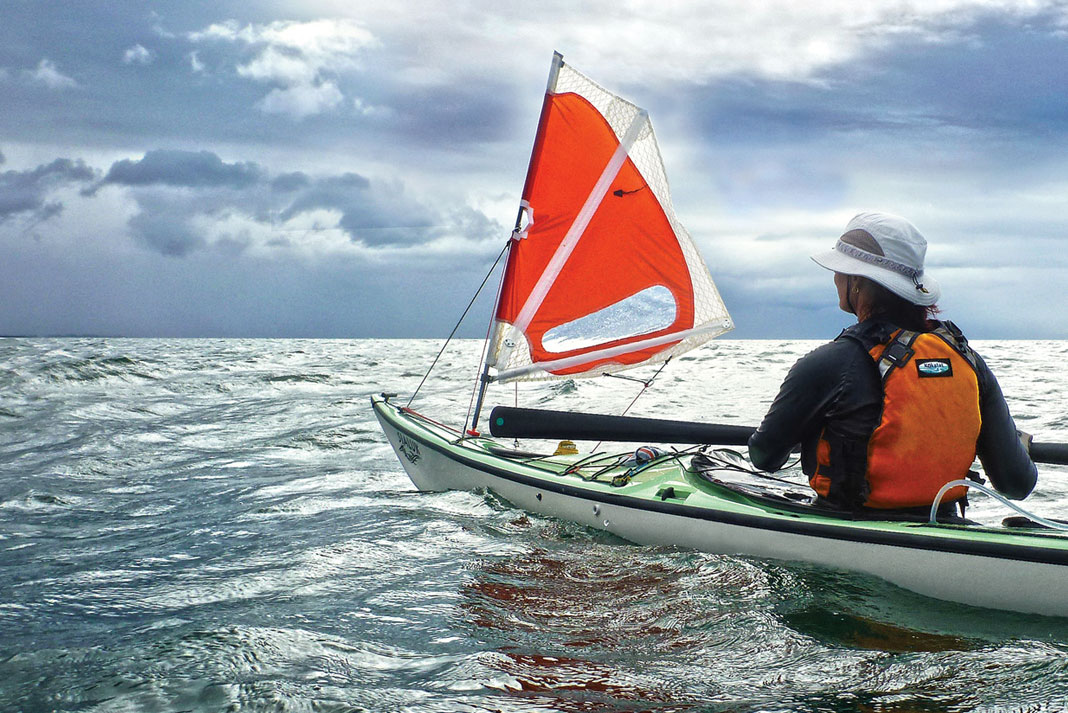Somehow, I’ve wrapped the sheet line around the mast. I can’t pull it free. Fourteen knots blows my sail sideways as I try to clear a field of pilings. Fighting for control, I dig my blade in and manage to power away from the watery minefield.
Mark paddles over. “You could have just released the up-haul line,” he laughs, unwrapping the flapping tangle on my deck. I’ve officially made my first greenhorn mistake in the world of kayak sailing.
Welcome to the world of kayak sailing
I’m learning the basics of sailing a sea kayak from Mark Whitaker, co-owner of Columbia River Kayaking. I admit to being a reluctant sailor, dreading the snarled lines and the idea of spending my afternoon wrestling with an eight-square-foot sheet of sail cloth instead of paddling. But that’s changing.
We’ve each suction-cupped an Australian-made Flat Earth Kayak Sail to our bow and Mark is showing me how to ride downwind, sail across the wind and tack upwind. These compact, “D”-shaped sails are designed to supplement the paddler’s power rather than replace it. Mounted well forward out of the paddler’s way, they permit the full range of strokes, rescues and even rolls. If necessary, the sail can be stowed quickly on the deck… unless, of course, you’re a newbie who forgets to release the anchor line.
Around the world, paddling cultures evolve to fit their environments. In Britain, kayakers surf tidal races. On the Pacific Coast, we explore swell-tossed rock gardens. Australian paddlers, meanwhile, have long been preoccupied with harnessing the wind. Down Under, sails are considered by many to be standard safety equipment, like a tow system or spare paddle, and are required by a number of kayak clubs for offshore journeys.
“Sails increase speed and range, reduce exposure during long crossings and conserve energy for crux moves,” says Ginni Callahan, an avid sailor who, along with business partner Whitaker, imports Flat Earth sails for Columbia River Kayaking. “You can get out of a situation faster, and raft up to sail someone who’s injured and needs help.”
Of course, it’s not quite that simple. First, I stumble through the salty sailing jargon: batten, up-haul, reefing, sheet line. Then there’s learning to catch the wind without getting yanked sideways into the drink. Edging, bracing and rolling with a sail require technique adjustments and practice.
Sydney, Australia-based kayak instructor and expedition leader Rob Mercer notes that sails magnify both the power of the paddler and the risks if something goes wrong. You’re moving much faster with a sail, which means less reaction time. Concentrating on sails and lines also shrinks the paddler’s bubble of awareness. Groups can become separated very quickly if one paddler drops his sail and the others fail to notice.
Despite the challenges, kayak sails are more user-friendly than ever before. Hobie offers sail kits for their Mirage sit-on-tops, and their Adventure and Tandem Island kayaks are fully kitted for sailing, including dual outriggers for stability. Australian manufacturers continue to lead design progression for aftermarket touring kayak sails, but North American companies like Falcon Kayak Sails, Balogh Sail Designs and WindPaddle Sails are catching up.
“There is a growing subculture embracing kayak sailing, such as the WaterTribe events on the East Coast,” says Callahan. “We’re in an age of re-combining ideas. Putting sails on kayaks is an example of that. I expect we’ll see more sails on more boats in the future.”
5 tips to learn how to sail a kayak
1 Climb the curve
There’s a lot to learn up front. Take a class or go out with experienced sailors in mild wind. Remember “mild” is defined at least partially by the size of your sail.
2 Size isn’t everything
Small sails remain manageable in stronger wind and have reduced consequences when you miscalculate. The trade-off is less wind gathering in calm conditions.
3 Manage safety issues
Practice and refine recoveries and stowing the sail in light wind.
4 Within limits
Don’t let the thrill of sailing take you beyond your limits, cautions Callahan: “Remember that if the wind dies or changes, you may have to paddle back.”
5 Mind the deck
Rigging the sail’s hardware may require deck reinforcement on kayaks with light layups. Or try a mount made from Sticky Pods, suction cups designed to attach cameras to race cars. According to Whitaker, they hold until about 45 knots.
Neil Schulman wonders if buying a sail makes him eligible for the renewable energy tax credit.
Set sail and away! | Feature photo: Damiano Visocnik
